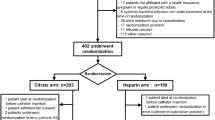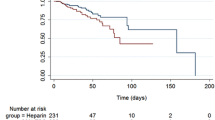Abstract
Purpose
Sodium citrate has antibacterial and anticoagulant properties that are confined to the catheter when used as a catheter lock. Studies of its use as a catheter lock in chronic hemodialysis patients suggest it may be efficacious in preventing infection and thrombotic complications. We compared sodium citrate with saline catheter locks for non-tunneled hemodialysis central venous catheters in critically ill adult patients. Primary endpoint was catheter life span without complication.
Methods
This was a randomized, controlled, open-label trial involving intensive care patients with acute renal failure requiring hemodialysis. Events were defined as catheter-related bloodstream infection and catheter malfunction.
Results
Seventy-eight patients were included. Median catheter life span without complication was 6 days (saline group) versus 12 days (citrate group) [hazard ratio (HR) 2.12 (95% CI 1.32–3.4), p = 0.0019]. There was a significantly higher rate of catheter malfunction in the saline group compared with in the citrate group (127 catheter events/1,000 catheter-days, saline group vs. 26 events/1,000 catheter-days, citrate group, p < 0.00001). There was no significant difference in incidence of infections between groups. We observed a significantly longer time to occurrence of infection in the citrate group (20 days vs. 14 days, HR 2.8, 95% CI 1.04–7.6, p = 0.04). By multivariate analysis, age and citrate group were the only independent factors that influenced catheter life span.
Conclusions
This study shows for the first time that citrate lock reduced catheter complications and increased catheter life span as compared to saline lock in critically ill adults requiring hemodialysis.


Similar content being viewed by others
References
Agee KR, Balk RA (1992) Central venous catheterization in the critically ill patient. Crit Care Clin 8:677–686
Canaud B, Leray-Moragues H, Leblanc M, Klouche K, Vela C, Beraud JJ (1998) Temporary vascular access for extracorporeal renal replacement therapies in acute renal failure patients. Kidney Int Suppl 66:S142–S150
Robert R, Honoré PM, Bastien O (2006) Les circulations extracorporelles en réanimation. Elsevier, Paris
Allon M (2003) Prophylaxis against dialysis catheter-related bacteremia with a novel antimicrobial lock solution. Clin Infect Dis 36:1539–1544. doi:10.1086/375234
Hendrickx L, Kuypers D, Evenepoel P, Maes B, Messiaen T, Vanrenterghem Y (2001) A comparative prospective study on the use of low concentrate citrate lock versus heparin lock in permanent dialysis catheters. Int J Artif Organs 24:208–211
Vercaigne LM, Sitar DS, Penner SB, Bernstein K, Wang GQ, Burczynski FJ (2000) Antibiotic-heparin lock: in vitro antibiotic stability combined with heparin in a central venous catheter. Pharmacotherapy 20:394–399
Bailey E, Berry N, Cheesbrough JS (2002) Antimicrobial lock therapy for catheter-related bacteraemia among patients on maintenance haemodialysis. J Antimicrob Chemother 50:615–617
Poole CV, Carlton D, Bimbo L, Allon M (2004) Treatment of catheter-related bacteraemia with an antibiotic lock protocol: effect of bacterial pathogen. Nephrol Dial Transplant 19:1237–1244. doi:10.1093/ndt/gfh041
Grudzinski L, Quinan P, Kwok S, Pierratos A (2007) Sodium citrate 4% locking solution for central venous dialysis catheters–an effective, more cost-efficient alternative to heparin. Nephrol Dial Transplant 22:471–476. doi:10.1093/ndt/gfl606
Lok CE, Appleton D, Bhola C, Khoo B, Richardson RM (2007) Trisodium citrate 4%—an alternative to heparin capping of haemodialysis catheters. Nephrol Dial Transplant 22:477–483. doi:10.1093/ndt/gfl570
Weijmer MC, Debets-Ossenkopp YJ, Van De Vondervoort FJ, ter Wee PM (2002) Superior antimicrobial activity of trisodium citrate over heparin for catheter locking. Nephrol Dial Transplant 17:2189–2195
Weijmer MC, van den Dorpel MA, Van de Ven PJ, ter Wee PM, van Geelen JA, Groeneveld JO, van Jaarsveld BC, Koopmans MG, le Poole CY, Schrander-Van der Meer AM, Siegert CE, Stas KJ (2005) Randomized, clinical trial comparison of trisodium citrate 30% and heparin as catheter-locking solution in hemodialysis patients. J Am Soc Nephrol 16:2769–2777. doi:10.1681/ASN.2004100870
Ash SR, Mankus RA, Sutton JM, Criswell RE, Crull CC, Velasquez KA, Smeltzer BD, Ing TS (2000) Concentrated sodium citrate (23%) for catheter lock. Hemodial Int 4:22–31
Hemmelgarn BR, Moist LM, Lok CE, Tonelli M, Manns BJ, Holden RM, LeBlanc M, Faris P, Barre P, Zhang J, Scott-Douglas N (2011) Prevention of dialysis catheter malfunction with recombinant tissue plasminogen activator. N Engl J Med 364:303–312. doi:10.1056/NEJMoa1011376
Allon M (2007) Current management of vascular access. Clin J Am Soc Nephrol 2:786–800. doi:10.2215/CJN.00860207
Yahav D, Rozen-Zvi B, Gafter-Gvili A, Leibovici L, Gafter U, Paul M (2008) Antimicrobial lock solutions for the prevention of infections associated with intravascular catheters in patients undergoing hemodialysis: systematic review and meta-analysis of randomized, controlled trials. Clin Infect Dis 47:83–93. doi:10.1086/588667
Yevzlin AS, Sanchez RJ, Hiatt JG, Washington MH, Wakeen M, Hofmann RM, Becker YT (2007) Concentrated heparin lock is associated with major bleeding complications after tunneled hemodialysis catheter placement. Semin Dial 20:351–354. doi:10.1111/j.1525-139X.2007.00294.x
Selleng K, Warkentin TE, Greinacher A (2007) Heparin-induced thrombocytopenia in intensive care patients. Crit Care Med 35:1165–1176. doi:10.1097/01.CCM.0000259538.02375.A5
Priziola JL, Smythe MA, Dager WE (2010) Drug-induced thrombocytopenia in critically ill patients. Crit Care Med 38:S145–S154. doi:10.1097/CCM.0b013e3181de0b88
Strauss R, Wehler M, Mehler K, Kreutzer D, Koebnick C, Hahn EG (2002) Thrombocytopenia in patients in the medical intensive care unit: bleeding prevalence, transfusion requirements, and outcome. Crit Care Med 30:1765–1771
Kellum JA, Mehta RL, Angus DC, Palevsky P, Ronco C (2002) The first international consensus conference on continuous renal replacement therapy. Kidney Int 62:1855–1863. doi:10.1046/j.1523-1755.2002.00613.x
O’Grady NP, Alexander M, Burns LA, Dellinger EP, Garland J, Heard SO, Lipsett PA, Masur H, Mermel LA, Pearson ML, Raad, II, Randolph AG, Rupp ME, Saint S (2011) Guidelines for the prevention of intravascular catheter-related infections. Am J Infect Control 39:S1–34. doi:10.1016/j.ajic.2011.01.003
McGee DC, Gould MK (2003) Preventing complications of central venous catheterization. N Engl J Med 348:1123–1133. doi:10.1056/NEJMra011883
Allon M (2004) Dialysis catheter-related bacteremia: treatment and prophylaxis. Am J Kidney Dis 44:779–791
Le Gall JR, Neumann A, Hemery F, Bleriot JP, Fulgencio JP, Garrigues B, Gouzes C, Lepage E, Moine P, Villers D (2005) Mortality prediction using SAPS II: an update for French intensive care units. Crit Care 9:R645–R652. doi:10.1186/cc3821
Fleming TR (1982) One-sample multiple testing procedure for phase II clinical trials. Biometrics 38:143–151
Maki DG, Ash SR, Winger RK, Lavin P (2011) A novel antimicrobial and antithrombotic lock solution for hemodialysis catheters: a multi-center, controlled, randomized trial. Crit Care Med 39:613–620. doi:10.1097/CCM.0b013e318206b5a2
Timsit JF, Bruneel F, Cheval C, Mamzer MF, Garrouste-Orgeas M, Wolff M, Misset B, Chevret S, Regnier B, Carlet J (1999) Use of tunneled femoral catheters to prevent catheter-related infection. A randomized, controlled trial. Ann Intern Med 130:729–735
Parienti JJ, Thirion M, Megarbane B, Souweine B, Ouchikhe A, Polito A, Forel JM, Marque S, Misset B, Airapetian N, Daurel C, Mira JP, Ramakers M, du Cheyron D, Le Coutour X, Daubin C, Charbonneau P (2008) Femoral vs jugular venous catheterization and risk of nosocomial events in adults requiring acute renal replacement therapy: a randomized controlled trial. JAMA 299:2413–2422. doi:10.1001/jama.299.20.2413
Parienti JJ, Megarbane B, Fischer MO, Lautrette A, Gazui N, Marin N, Hanouz JL, Ramakers M, Daubin C, Mira JP, Charbonneau P, du Cheyron D (2010) Catheter dysfunction and dialysis performance according to vascular access among 736 critically ill adults requiring renal replacement therapy: a randomized controlled study. Crit Care Med 38:1118–1125. doi:10.1097/CCM.0b013e3181d454b3
Uhl L, Maillet S, King S, Kruskall MS (1997) Unexpected citrate toxicity and severe hypocalcemia during apheresis. Transfusion 37:1063–1065
Power A, Duncan N, Singh SK, Brown W, Dalby E, Edwards C, Lynch K, Prout V, Cairns T, Griffith M, McLean A, Palmer A, Taube D (2009) Sodium citrate versus heparin catheter locks for cuffed central venous catheters: a single-center randomized controlled trial. Am J Kidney Dis 53:1034–1041. doi:10.1053/j.ajkd.2009.01.259
Dogra GK, Herson H, Hutchison B, Irish AB, Heath CH, Golledge C, Luxton G, Moody H (2002) Prevention of tunneled hemodialysis catheter-related infections using catheter-restricted filling with gentamicin and citrate: a randomized controlled study. J Am Soc Nephrol 13:2133–2139
Berenholtz SM, Pronovost PJ, Lipsett PA, Hobson D, Earsing K, Farley JE, Milanovich S, Garrett-Mayer E, Winters BD, Rubin HR, Dorman T, Perl TM (2004) Eliminating catheter-related bloodstream infections in the intensive care unit. Crit Care Med 32:2014–2020
Warren DK, Zack JE, Mayfield JL, Chen A, Prentice D, Fraser VJ, Kollef MH (2004) The effect of an education program on the incidence of central venous catheter-associated bloodstream infection in a medical ICU. Chest 126:1612–1618. doi:10.1378/chest.126.5.1612
Kaplowitz LG, Comstock JA, Landwehr DM, Dalton HP, Mayhall CG (1988) A prospective study of infections in hemodialysis patients: patient hygiene and other risk factors for infection. Infect Control Hosp Epidemiol 9:534–541
Acknowledgments
We are grateful to the patients and their families and the nurses and physicians in the participating ICU for their support of this trial. We would also like to thank the clinical research division (DRCI) of the University Hospital of Dijon for their support. The authors thank Fiona Ecarnot for translation and editorial assistance. This work was financed by the University Hospital of Dijon Clinical Research Division.
Conflict of interest
None.
Author information
Authors and Affiliations
Corresponding author
Additional information
L. Hermite, J.-P. Quenot, A. Nadji, and S. D. Barbar contributed equally to the work.
Rights and permissions
About this article
Cite this article
Hermite, L., Quenot, JP., Nadji, A. et al. Sodium citrate versus saline catheter locks for non-tunneled hemodialysis central venous catheters in critically ill adults: a randomized controlled trial. Intensive Care Med 38, 279–285 (2012). https://doi.org/10.1007/s00134-011-2422-y
Received:
Accepted:
Published:
Issue Date:
DOI: https://doi.org/10.1007/s00134-011-2422-y




